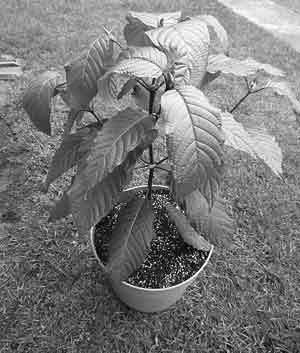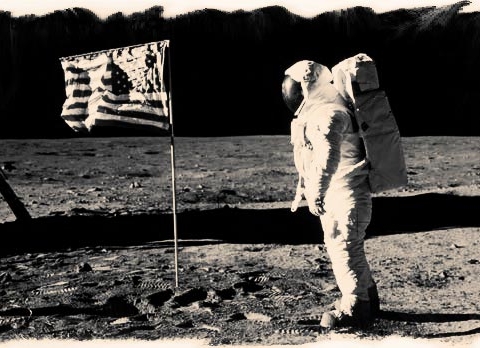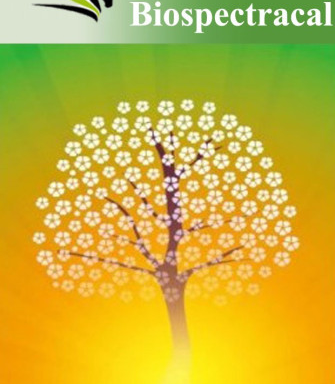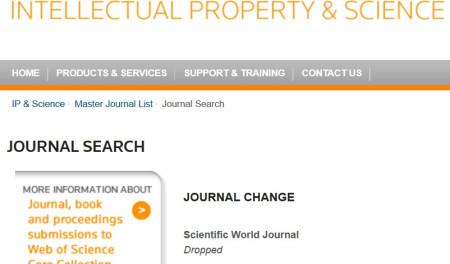
The troubled publication Scientific World Journal will once again lose its impact factor (this time for 2014), according to one Thomson Reuters website and reports I have received. Web of Science deleted the title (i.e., will no longer index articles) on August 23, 2014.
No mention of any impact factor appears on the journal’s home page, here: http://www.hindawi.com/journals/tswj/
Also, a Thomson Reuters website entitled “Thomson Reuters Master Journal List JOURNAL COVERAGE CHANGES (for the past 12 months)” generates the result shown in the image above when the journal’s title is searched. The result says, “Dropped.” No reason is given. That website is here.
Soon after Hindawi Publishing Corporation purchased this journal in 2012, Thomson Reuters suppressed the journal’s 2011 impact factor due to an “anomalous citation pattern” that occurred apparently before Hindawi purchased the journal from its previous owner but reported impact factors for both 2012 and 2013 and, oddly, 5 year impact factors, all of which include 2011 data.
I reported on this impact factor suppression here.
I also learned that these two Hindawi journals have also been dropped by Thomson Reuters
o Abstract and Applied Analysis
o Journal of Applied Mathematics
The situation for these two journals is the same as it is with the Scientific World Journal. There is no mention of any impact factor on the journal’s website, Thomson Reuters reports the journals have been dropped, but Journal Citation Reports will continue to show an impact factor for both titles through 2013.
An inquiry sent to Thomson Reuters received this response regarding the three journals:
“In this situation, two of our editors noticed abnormal citation patterns between these three journals and a rapid decline of journal quality. They determined that these should be removed as quickly as possible from the Web of Science to preserve our reputation for quality and maintain the trust of the research community.”
Intensive Spamming
Hindawi Publishing Corporation is currently involved in an intensive spamming campaign. Scholars from all over the world have been forwarding me spam emails they have recently received from Hindawi, and I personally received a spam email requesting that I submit a paper to their highly focused Geography Journal. I am an academic librarian and don’t have a formal background in Geography.
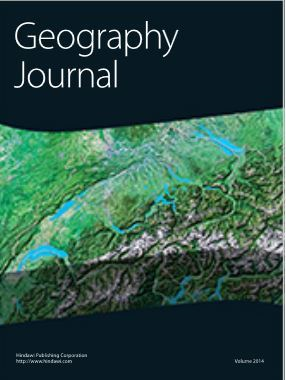
On its website, Hindawi reports that it “is a rapidly growing academic publisher with 434 peer-reviewed, open access journals covering a wide range of academic disciplines.” Perhaps it is growing too quickly.
Conclusion
I have also heard about a questionable article that appears in Hindawi’s Journal of Lipids. The article is entitled “Why Fish Oil Fails: A Comprehensive 21st Century Lipids-Based Physiologic Analysis.”
Finally, here is a blog post by ravingscientist01 that reports on a questionable article published in Hindawi’s journal Biomed Research International.
UPDATE 2014-10-15: Response from Hindawi Publishing corporation:
My name is Paul Peters and I am the Chief Strategy Officer for Hindawi. It is indeed true that three of Hindawi’s journals (“The Scientific World Journal,” “Abstract and Applied Analysis,” and “Journal of Applied Mathematics”) were deselected for coverage in the Science Citation Index Expanded on September 15. As soon as the deselection of these journals was announced, Hindawi contacted the authors and editors of these journals to inform them of this decision and updated the journal websites accordingly. Hindawi fully acknowledges that Thomson Reuters has the editorial freedom to determine which journals are included in its databases, however I would like to respond to the two specific points of concern that were mentioned in this blog post.
I would first like to respond to the issue of citation stacking between these three journals. Prior to the release of the most recent Journal Citation Reports (JCR) in July 2014, Thomson Reuters conducted a full analysis of self-citations and citation stacking, which resulted in the suppression of 38 journals from the most recent JCR. None of the three deselected journals from Hindawi were included in this list of suppressed journals. In addition, Hindawi has analyzed the citations that each of these three journals have received within Web of Science so far in 2014 and found the following results:
– The Scientific World Journal has received a total of 3,627 citations in 2014, of which there are 19 citations from Abstract and Applied Analysis and 11 citations from the Journal of Applied Mathematics. – Abstract and Applied Analysis has received a total of 2,356 citations in 2014, of which there are 86 citations from The Scientific World Journal and 79 citations from Journal of Applied Mathematics. – Journal of Applied Mathematics has received a total of 870 citations in 2014, of which there are 43 citations from The Scientific World Journal and 122 from Abstract and Applied Analysis.
I would also like to respond to the issue of declining quality in these three journals. The most straightforward quality metric to look at in judging the quality of these journals is the Impact Factor for each of these titles. While there are limitations to what the Impact Factor can measure, it is a useful metric for comparing the citation impact of content published in journals that are within a particular subject category.
Abstract and Applied Analysis’ Impact Factor ranks the journal as number 22 out of 299 journals in the Mathematics subject category in the most recent Journal Citation Reports, which places it among the top 10% of all math journals in the Web of Science. The Impact Factor for the Journal of Applied Mathematics is roughly at the mid-point of the Applied Mathematics subject category (number 130 out of 250 total journals) in the most recent JCR. Finally, The Scientific World Journal’s Impact Factor places it in the top third of all journals (16 out of 55 journals) in the Multidisciplinary Sciences subject category.
If self-citations are excluded from the Impact Factor calculations of all journals, Abstract and Applied Analysis would be ranked number 49 out of 299 journals in Mathematics, the Journal of Applied Mathematics would be ranked number 154 out of 250 journals in Applied Mathematics, and The Scientific World Journal would be ranked number 14 out of 55 journals in Multidisciplinary Sciences.
Hindawi understands that for many authors it is important for these journals to be indexed in the Science Citation Index Expanded so that publications in these journals can be considered in research assessment exercises as well as tenure and promotion reviews. Hindawi will continue working with Thomson Reuters in order to respond to any concerns that they may have in the hope that these journals will be considered for inclusion in the Science Citation Index Expanded in the future
By: Jeffrey Beall
Follow on Twitter
Source: Scholarly Open Access
Comments:
Siddiq Ali Chishti Lecturer FIS says:
October 14, 2014 at 9:16 AM
Dear Jeffrey Beall, Hope you will be doing fine. I just wanted your favor regarding knowing the academic status of a journal named ” European Journal of Social Sciences”. I intend to submit my article to them but first I need your opinion about their status. I shall be thankful to you for your cooperation. Kind regards, Siddiq Ali
Jeffrey Beall says:
October 14, 2014 at 9:23 AM
I strongly recommend that you not submit your paper to that journal. It is a counterfeit publisher.
oannis says:
September 3, 2015 at 1:10 AM
Hi there!
How it can be European when it is based in Seychelles?
Just for the record, Seychelles is in the Indian Ocean…
M. Salmani says:
October 14, 2014 at 11:07 AM
I am curious to know why don’t you add Hindawi publisher to your list and if that is that case, why to you refrain to add your famous sentence “I strongly recommend against submitting scholarly papers to all XXX journals published by XXX ” to the conclusion in this post? We would appreciate if you could clarify or elaborate on it.
Wojciech says:
October 14, 2014 at 11:36 AM
Dear Sir. I think that you must add now Hindawi in your Predatory Publishers. Their journals do not have peer review. They demand a lot of USD for publishing an article. Their journals do not have Editor-in-Chief. They have published some ridiculous non-scientific papers. You must be fair and honest. Add them in the predatory publishers list. I dare you. Otherwise, you are not fair and you give advantages to Hindawi against MDPI and SCIRP that are like Hindawi but blacklisted by you
Dave Langers says:
October 14, 2014 at 1:57 PM
I’ve done some reviewing for “Neural Plasticity”, from Hindawi. I was suspicious, but did not encounter anything out of the ordinary. Quite a good paper, if I remember correctly, and I find the journal content entirely legit.
I realise this is N=1, but this particular journal does /not/ seem to belong on the crap pile. No idea about any of the other Hindawi journals, although I can imagine that the quality “diverges” from case to case.
Based on my experience, I do not recommend a phrase like “I strongly recommend against submitting scholarly papers to all XXX journals published by XXX”, as suggested above.
(Disclosure: apart having done one review for them, I have no link with this journal of publisher whatsoever.)
A. Boucherif says:
February 20, 2015 at 5:53 AM
ISI indexing is a business making money on the back of scientists. Every Hindawi Math. Journal has an editor-in-chief and the review process is as clean as any other math. journal. There are ridiculous paper in every journal. Many US and European journal are rejecting papers on a geographical basis without review process. I believe the scientific community should go for google scholar indexing and scopus.
Marriam says:
October 17, 2014 at 9:28 AM
Dear Jeffrey Beall
Please do some favour by clear the present situation regarding present impact factor of Scientific World Journal. The name of the is there in Journal Citation Reports 2013, which will be valid un-till next Journal Citation Reports, likely to be published in july 2015. Does this mean it has still impact factor but will lose in next Journal Citation Reports?
Jeffrey Beall says:
October 17, 2014 at 10:21 AM
Yes, I think it does.
PK says:
October 18, 2014 at 7:53 AM
Should reputed journals such as Science accept full page color ads from Hindwai? Almost every issue of Science includes a full page ad promoting their publications
CSSE – not! says:
October 18, 2014 at 1:53 PM
I agree that Hindawi should be added to Beall’s list, for one simple reason, they treat science like a cattle market. Although the e-mail dated October 17, 2014 was in fact addressed to me (using automatic mail spoolers to cover up the spamming nature), notice the “negotiation” of the removal of all publishing fees if I submitted within 14 days. Which scientist can produce a paper within 14 days, I ask?
“On Tuesday, September 30, 2014 12:07 PM, International Journal of Genomics wrote:
Dear Dr. Teixeira Da Silva,
It is my pleasure to invite you to submit an invited contribution to International Journal of Genomics (formerly titled Comparative and Functional Genomics), which is a peer-reviewed, open access journal that publishes original research articles as well as review articles dealing with the post-sequencing phases of genome analysis. The most recent Impact Factor for International Journal of Genomics is 1.747 according to 2013 Journal Citation Reports released by Thomson Reuters (ISI) in mid 2014.
International Journal of Genomics is published using an open access publication model, meaning that all interested readers are able to freely access the journal online at http://www.hindawi.com/journals/ijg/ without the need for a subscription, and authors retain the copyright of their work. Moreover, all published articles will be made available on PubMed Central and indexed in PubMed at the time of publication.
The journal has a distinguished Editorial Board with extensive academic qualifications, ensuring that the journal maintains high scientific standards and has a broad international coverage. A current list of the journal’s editors can be found at http://www.hindawi.com/journals/ijg/editors/.
Publishing an article in International Journal of Genomics requires Article Processing Charges of $1,500. However, if you can send your paper to me directly by email before the end of October 2014, I will be happy to waive the Article Processing Charges for this invited contribution.
Please do not hesitate to contact me if you have any questions.
Best regards,
Monica Toma
——————————–
Monica Toma
Editorial Office
International Journal of Genomics
Hindawi Publishing Corporation
http://www.hindawi.com”
Science publishing has become a disgrace.
Wim Crusio says:
October 18, 2014 at 12:08 PM
I am a but puzzled by Thomson Reuters” policies. This journal has in 2013 5% self cites to years that are used in the 2013 IF calculation (2011 and 2012). A journal like Rejuvenation Research has over 40% (and almost no self-cites to years that are not important for the IF calculation…) and has had such high rates for years (sometimes even higher). Why is TSWJ fropped, but RR kept?
chawla says:
October 18, 2014 at 9:51 PM
I have noted that many journals in the past are dropped from “Science Citation Index Expanded”, but after some time they reactivated again.
http://admin-apps.webofknowledge.com/JCR/JCR?RQ=RECORD&rank=16&journal=SCI+WORLD+J
TSWJ is still on web of knowledge “Thomoson Reuters’s impact factor list”. In above link it has still impact factor 1.219. It may be reactivted again before the new impact factor list, which normally published in July each year. So it is not confirmed, it will lose its impact factor.
Jeffrey Beall says:
October 19, 2014 at 8:16 AM
I think it’s confirmed that it will not have an impact factor for 2014.
Hasib Khan says:
November 13, 2014 at 8:48 AM
Dear Jeffery Beall
What will be the position of the papers which have accepted before September 2014? Those papers will have the impact factor or they also lost their impact factor?
Jeffrey Beall says:
November 13, 2014 at 11:31 AM
Actually, papers don’t have impact factors. Only journals have impact factors. But I think it’s safe to say that the papers were published when the journal had an impact factor.
A says:
October 19, 2014 at 8:48 AM
Dear Jeffrey Beall
I am a Ph.D scholar from Pakistan. I have a research Article in The Scientific World Journal. There should be one research article of non-zero impact factor for the submission of Ph.D thesis in Pakistan. May I submit my thesis on the basis of above mentioned article before July 2015. Please reply, its a matter of huge concern for me.
Jeffrey Beall says:
October 19, 2014 at 9:22 AM
Of course, you are free to do whatever you choose.
The journal currently has a 2013 impact factor. My understanding is that it will not have a 2014 impact factor, and Thomson Reuters currently lists it as “dropped.”
A says:
October 19, 2014 at 9:29 AM
So I can submit my Thesis before 2014 or not. They demand 1 paper in a journal having impact factor. Now a days 2013 list is valid, in which it has impact factor.
J.J. says:
October 20, 2014 at 7:26 AM
@A The only people who can help you with this issue are the member of your thesis committee, ask them. Random strangers on the internet have no idea what will help you graduate.
As a side note, regardless of grad school requirement, a publication in this journal will probably not be highly regarded in future academic applications.
JBL says:
October 19, 2014 at 3:21 PM
Obviously you should discuss with your Ph.D. advisor and the chair of your department if you want to know what your departmental policies are.
IF – stop! says:
October 23, 2014 at 1:39 AM
And while following all the pleasant advice about speaking to your advisors, may I also suggest that you contact the Pakistani higher education authorities to stop using the IF as an equivalent of quality and to assess PhDs. When wll this pathetic game and dependence on the IF stop? It has corrupted science. No longer do students talk about the quality of their work, they just want to know about the IF of the journal it is published in. Young scientists must seek a novel way to step out of this very sick state science is in. The sooner we lose the IF, the better.
Riaz Uddin says:
October 19, 2014 at 7:22 PM
I was very optimistic about this publisher. Anyway, today I found one of the articles published in Advances in Public Health, a Hindawi journal which has only one author. Well its not unlikely and an article published by a single author is not a crime! But the nature of the study somehow demands more than one author. Let me explain: the author acknowledged this way “This study was carried out as the partial fulfillment of the degree of Masters in Public Health, UniSA School of Public Health and Life Sciences, University of South Asia.” So, either the author is the student or the supervisor. So, there should have been at least 2 authors.
Moreover, though the work was carried out for the purpose of a degree awarding the author used different affiliations. This is so confusing.
Here is the article: http://www.hindawi.com/journals/aph/2014/952832/
Do you have any comments? Do you think it as a scientific misconduct or do you think the editorial office of the publisher is ignoring something?
Thanks!
Jeffrey Beall says:
October 20, 2014 at 8:39 AM
Based on your description, I see no evidence of misconduct.
wimcrusio says:
October 20, 2014 at 9:00 AM
This is not unprecedented. My own thesis adviser once had a master’s student who wished to publish his results. My adviser was not sure of the data, so declined to be an author, but did permit the student to publish his master’s thesis work. The student became a successful researcher (but told me once that he’d never succeeded in replicating his master’s thesis work, so my advisor was right after all :-).
Kingsley N. Ukwaja says:
October 22, 2014 at 6:25 AM
Dear Beall,
After many years of following your work and visiting your site, I felt compelled to thank you for the great work you are doing and for helping the academic/scientific community.
I wish to drop a few lines about HINDAWI publisher. I believe the journals operated by this publisher are all legit. Agreed, they try to create additional journal titles almost on quarterly bases, they list the names of their journal editors (although no editor in chief) in their websites with their affiliation and recent works as indexed in scopus.
I am not sure why the TSWJ was listed as dropped in the JCR…But I have had three experiences with submitting three manuscripts in three different journals in HINDAWI publisher.
My first paper, submitted to one of their newer titles (in PubMEd, but not listed in JCR yet) was rejected. Three reviewers reviewed the work (the recommendations were minor revision, major revision, and rejection), respectively; but for unclear reasons the editor rejected the paper. I used the advice given by the reviewers to make changes and resubmitted to a journal (indexed in JCR and PubMed) with a different publisher (two recommendations were minor revisions) before the paper was accepted.
Since then, I have submitted two additional papers to two different HINDAWI-operated journals. Each was reviewed by at least two reviewers and went through two rounds of review before the papers were accepted.
Furthermore, compared to other open access publishers, I believe HINDAWI publishers appears to be the most friendly to the research community. Except for the month of October 2014, Since the beginning of this year, the publisher has had several offerings of article processing charge (APC) waivers for manuscripts submitted in some of their journals. Within the month the APC waivers were being offered, all manuscripts irrespective of country of origin submitted to the journal that were finally accepted are published free of charge.
Indeed, for my two manuscripts which were published this year (one published, the other in press) by journals operated by HINDAWI, I was not charged any APCs because I took advantage of the APC waivers offered by the journals (presently, the APCs for the journals are $600 and $800).
With my above experience, although I believe some of their titles are not yet perfect, I still think that the journal policies of HINDAWI publishers does not yet warrant inclusion in your list.
For the records, the above are just my experiences with this publisher.
Thank you once again Prof Beall.
Farzad says:
October 30, 2014 at 3:45 AM
The way that The scientific world journal is treated by Thomson Reuters is grotesque and suggests some prejudice which may have played a part in their decision. There is no doubt that Hindawi publication has a long way to go to reach the quality and reputation of some other publishers like Elsevier or Springer. However, it can not be denied that Hindawi is a rising new power in the academic community, which to some extent, challenges veteran publishers. We know that the margin profit of Hindawi surpassed that of Elsevier some time ago. I am not interested in putting forward some conspiracy theories and claim that those long-established and influential publishers may try to perniciously impact Hindawi through the tools such as Thomson Reuters, but excuse of self-citation provided by Thomson Reuters for removing The scientific world journal or Abstract and Applied Analysis from their list sounds not only unconvincing but rather flimsy. Ironically, if self-citation is going to establish a criterion for preserving or tarnishing reputation of Thomson Reuters or scientific community , then, many Elsevier or Springer-operated journals must either be dropped from JCR or lose their impact factor.
phpkelli says:
November 10, 2014 at 5:56 AM
This is really sad and if things keep going into the dark like this then soon the whole academic sector will die. I am disappointed in reading this and on the other hand I am glad that there are Journals like http://www.elkjournals.com/ who are working so hard to come up with new ways to help researchers and scholars. I recently got my journal paper submitted with them through their easy and quick publication process. Since I was left with very few days.


